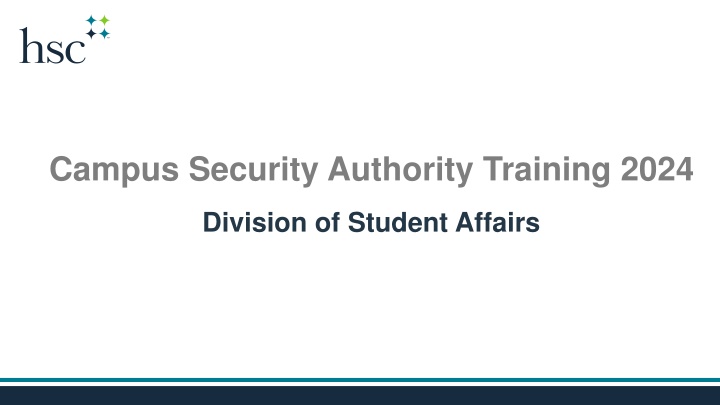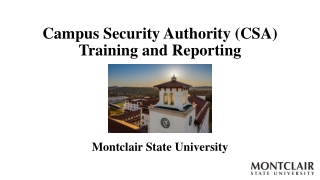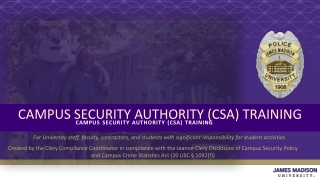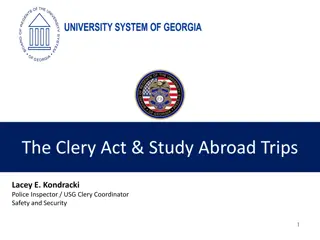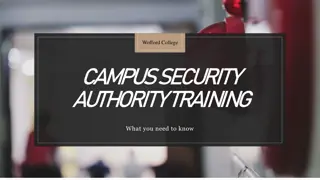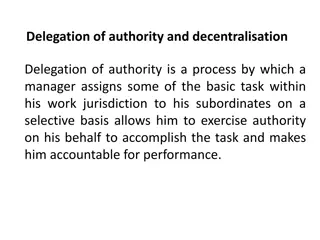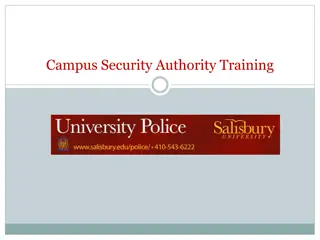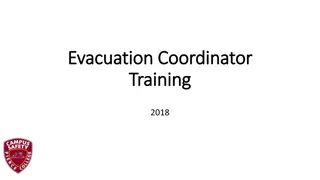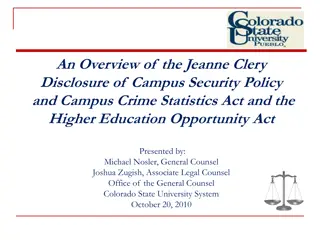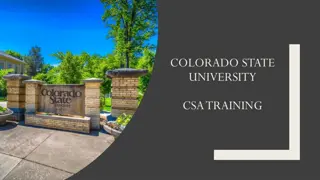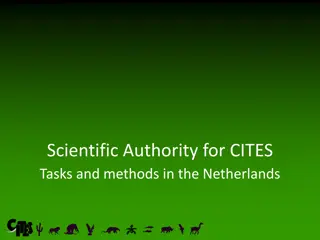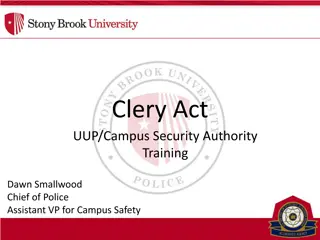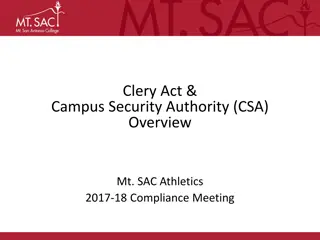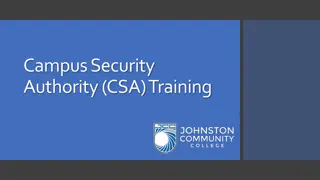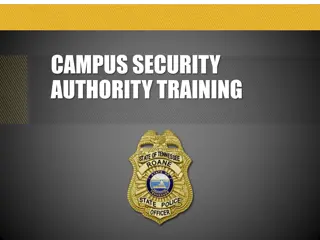Campus Security Authority Training 2024 - Understanding the Clery Act
The Clery Act, named after Jeanne Clery, aims to provide transparency on campus crime statistics and promote campus safety. Violating this federal law can lead to severe consequences such as fines and loss of Title IV funding. Institutions of higher education must comply with various requirements, including identifying Campus Security Authorities, collecting crime statistics, and issuing timely notifications. This training is crucial to ensure compliance with the Clery Act and maintain a safe campus environment.
Download Presentation

Please find below an Image/Link to download the presentation.
The content on the website is provided AS IS for your information and personal use only. It may not be sold, licensed, or shared on other websites without obtaining consent from the author.If you encounter any issues during the download, it is possible that the publisher has removed the file from their server.
You are allowed to download the files provided on this website for personal or commercial use, subject to the condition that they are used lawfully. All files are the property of their respective owners.
The content on the website is provided AS IS for your information and personal use only. It may not be sold, licensed, or shared on other websites without obtaining consent from the author.
E N D
Presentation Transcript
Campus Security Authority Training 2024 Division of Student Affairs
What is the What is the Clery Clery Act? Act? Jeanne Clery was a student at Lehigh University and was sexually assaulted and murdered in her residence hall room by another student in 1986. Lehigh University hadn t informed students about 38 violent crimes on campus in the three years preceding her murder. The Clery Act (aka the Jeanne Clery Disclosure of Campus Security Policy & Campus Crime Statistics Act) was enacted in 1990 as a federal law, amended in 1998, and it requires institutions of higher education to disclose campus security information including crime statistics for the campus and surrounding areas to both current and prospective students, their families & employees. Purpose is to provide accurate, complete and timely information about crime and campus safety so that they can make an informed decision.
Consequences for Violating the Clery Act Consequences for Violating the Clery Act Loss of Title IV funding (federal financial aid) $69,733 fine per violation Example Penn State University $2.4 million fine ($2.1 million not related to Sandusky incidents) Fine based on previous $35,000 per violation 2008-2011 over 300 crimes not disclosed 5 of the undisclosed crimes were Sexual Assault Offenses Source: NY Times
What is required by the What is required by the Clery Clery Act? Act? Identify Campus Security Authorities (CSAs) Determine HSC s Clery geography Collect crime statistics By October 1st of each year, the Annual Security Report (ASR) must be published and distributed Notify the campus in a timely manner when crimes threaten safety and issue emergency notifications Maintain an up-to-date daily log of all reported crimes Submit crime statistics to the U.S. Department of Education
Identifying Campus Security Authorities Identifying Campus Security Authorities In order to ensure all criminal activity is disclosed, the Clery Act requires the HSC to identify individuals and the organizations to which crimes may be reported as a result of their position with HSC. These individuals and organizations are called Campus Security Authorities (CSAs). If you re participating in this training, the HSC has identified your position as a CSA and you have specific responsibilities that are required by federal law.
Campus Security Authorities Campus Security Authorities According to the Clery Act, CSAs are employees who have significant responsibility for student and campus activities. In order to comply with the Clery Act, campus administrators must: Define who the campus security authorities are in the Annual Security Report (ASR); Describe their responsibilities; and Educate them about their role.
Who is considered a CSA at HSC? Who is considered a CSA at HSC? Four categories: Members of the HSC Police Department (commissioned and non- commissioned) Individuals who have a responsibility for campus security but are not members of the HSC Police Department (i.e. event security) Individuals or organizations specified by the HSC statement of campus security policy as someone that students should report criminal offenses Individuals who have a significant responsibility for student and campus activities, including, but not limited to student discipline and campus judicial proceedings
Who is NOT considered a HSC CSA? Who is NOT considered a HSC CSA? Faculty member who does not have any responsibility for students and campus activities beyond the classroom Clerical or cafeteria staff Facilities or maintenance staff Any support position that does not have significant responsibility for students and campus activities
CSA Responsibilities CSA Responsibilities It is the CSAs obligation and responsibility to report a crime, whether or not the victim elects to pursue criminal charges or report to the police. If the person does not want to contact the police, the CSA should report the crime to the HSC Police Department at 3600 Mattison Avenue or (817) 735-2210 for non-emergencies and (817) 735-2600 for emergencies. If the person states they will report the crime themselves, the CSA should follow up and verify if the crime was reported to the HSC Police Department.
CSA CSA Responsibilities CSAs must submit the Crime Statistic Report survey that is sent via email on a quarterly basis from the Division of Student Affairs. However, reports of crime should be made immediately to the HSC Police Department, should they occur.
CSA Responsibilities CSA Responsibilities Incidents may be beyond the CSAs comfort level and it is not the role of the CSA to determine whether or not a crime took place, but only to report it. CSAs may refer victims to trained individuals on campus: Title IX Coordinator: Dr. Maureen McGuinness, Maureen.McGuinness@untsystem.edu; SSC 160; (817) 735-5919 Trust Line: www.unthsc.edu/letstalk or 844-692-6025 HSC PD: 3600 Mattison Avenue or (817) 735-2210
CSA Reporting CSA Reporting Reports from CSAs will be used to: Fulfill HSC s responsibility to annually disclose Clery crime statistics To issue timely warnings for Clery crimes that pose a threat to our campus community To enter the information in the Daily Crime Log
CSA Reporting CSA Reporting Police Report: Used by the HSC Police Department to initiate a criminal investigation. HSC Police Department (817) 735-2210 www.unthsc.edu/police 3600 Mattison Avenue CSA Report: An online report made by a CSA which will be sent to the HSC Police Department if it meets Clery requirements.
Not CSA Responsibilities Not CSA Responsibilities Investigating a crime. Determining whether a crime occurred. Apprehending criminals.
CSA Resources CSA Resources Off-Campus Resources: Domestic Violence Against Women and Children 1 (877) 701-SAFE (7233) MHMR of Tarrant County (817) 569-4300 or (817) 335-3022 National Stalking Resource Center www.victimsofcrime.org Rape Crisis and Victim Services - Fort Worth (817) 927-2737 or (817) 927-4039 Rape Crisis and Victim Services - Dallas (214) 590-0430 Rape Crisis and Victim Services - Denton (940) 382-7273 Safe Haven of Tarrant County (817) 535-6462 Student Assistance Program (confidential counseling) (866) 743-7732 Women s Center Counseling Services (817) 927-4000 or (817) 927-4040 One Safe Place (817) 885-7774 or (817) 916-4323 On-Campus Resources: Security Escort Services Emergency Phones Title IX Coordinator HSC PD Student Health Clinic
Clery Clery Geography Geography On Campus: Property owned or controlled by HSC that is reasonably contiguous to one another and directly supports or relates to HSC s educational purpose. Public Property: All public property that is within the same reasonably contiguous area, such as sidewalks, streets, thoroughfares, or parking, and is adjacent to HSC owned or controlled properties. Non-Campus: Buildings or property owned or controlled by a recognized student organization or by HSC for educational purposes and is used by students that is not within the same reasonably contiguous area.
Clery Crimes That Must Be Reported Clery Crimes That Must Be Reported Motor Vehicle Theft Arson Violence Against Women Act (VAWA) Dating Violence, Domestic Violence & Stalking Hate crimes Bias based on race, religion, sexual orientation, gender, gender identity, ethnicity, national origin, disability Criminal Homicide Sexual Assault (sex offenses) Rape, Fondling, Incest & Statutory Rape Robbery Aggravated Assault Burglary
Criminal Homicide Criminal Homicide Murder & Non-Negligent Manslaughter: The willful (non-negligent) killing of another human being by another. Manslaughter by Negligence: The killing of another person through gross negligence.
Sexual Assault (Sex Offenses) Sexual Assault (Sex Offenses) Rape: Penetration, no matter how slight, of the vagina or anus, with any body part or object, or oral penetration by a sex organ of another person without the consent of the victim. Fondling: Touching of the private body parts of another person for the purpose of sexual gratification, without the consent of the victim, including instances where the victim is incapable of giving consent because of age or mental incapacity. Incest: Sexual intercourse between persons who are related to each other within the degrees marriage is prohibited by law. Statutory Rape: Sexual intercourse with a person who is under the statutory age of consent.
Other Clery Crimes Other Clery Crimes Robbery: The taking or attempting to take anything of value from the care, custody, or control of a person(s) by force or threat of force or violence and/or by putting the victim in fear. Aggravated Assault: An unlawful attack by one person upon another for the purpose of inflicting severe or aggravated bodily injury. Burglary: Unlawful entry of a structure to commit a felony or a theft. Motor Vehicle Theft: Theft or attempted theft of a motor vehicle. Arson: Any willful or malicious burning or attempt to burn, with or without intent to defraud, a dwelling house, public building, motor vehicle or aircraft, personal property of another.
Hate Crimes Hate Crimes A criminal offense that manifests evidence that the victim was intentionally selected because of the perpetrator s bias against them. (Race, Religion, Sexual Orientation, Gender, Gender Identity, Ethnicity, National Origin, Disability) Larceny (Theft) : Unlawful taking, carrying, leading, or riding away of property from the possession or constructive possession of another. Simple Assault: Unlawful physical attack by one person upon another where neither the offender displays a weapon, nor the victim suffers obvious severe or aggravated bodily injury involving apparent broken bones, loss of teeth, possible internal injury, severe laceration, or loss of consciousness. Intimidation: Unlawfully placing another person in reasonable fear of bodily harm through the use of threatening words and/or other conduct, but without displaying a weapon or subjecting victim to a physical attack. Destruction/Damage/Vandalism of Property: To willfully or maliciously destroy, damage, deface, or otherwise injure personal property without the consent of the owner or the person having custody or control of it.
Violence Against Women Act Violence Against Women Act (VAWA) Clery Crimes (VAWA) Clery Crimes Dating Violence: Violence committed by a person who is or has been in a social relationship of a romantic or intimate nature with the victim. Domestic Violence: A felony or misdemeanor crime of violence committed by a current or former spouse or intimate partner of the victim; person with whom the victim shares a child in common; person who currently or formerly cohabited with as a spouse or intimate partner; person situated to a spouse of a victim under domestic or family violence laws of their jurisdiction; or by any person against an adult or youth victim who is protected from that person s acts under the domestic or family violence laws of the jurisdiction which the crime of violence occurred. Stalking: Engaging in a course of conduct directed at a specific person that would cause a reasonable person to fear for the person s safety or safety of others; or suffer substantial emotional distress.
Arrests/Disciplinary Referrals Arrests/Disciplinary Referrals Weapons Violations: Violations of law or ordinances prohibiting the manufacture, sale, purchase, transportation, possession, concealment, or use of firearms, cutting instruments, explosives, incendiary devices, or other deadly weapons. Drug Abuse Violations: Violations of law prohibiting the production, distribution, and/or use of certain controlled substances and the equipment or devices utilized in their preparation and/or use. Unlawful cultivation, manufacture, distribution, sale, purchase, use, possession, transportation, or importation of any controlled drug or narcotic substance. Arrests for violations of state or local laws specifically those relating to the unlawful possession, sale, use, growing, manufacturing and making of narcotic drugs. Liquor Law Violations: Violations of state or local laws or ordinances prohibiting the manufacture, sale, purchase, transportation, possession, or use of alcoholic beverages, not including driving under the influence and drunkenness.
Public Notices to the Campus Community Public Notices to the Campus Community Timely Warnings: Warning to the community that must be issued for any Clery crime that occurs on the HSC s Clery geography and is considered to represent a serious or continuing threat to students and employees. Emergency Notification: Notification that must be initiated for any significant emergency or dangerous situation involving an immediate threat to the health or safety of students and/or employees occurring on the campus.
Daily Crime Log Daily Crime Log A record of criminal incidents and/or alleged criminal incidents that are reported to the HSC Police Department and made available to the public. The log must contain the following: Date the crime was reported Date and time the crime occurred Nature of the crime General location of the crime Disposition of the complaint, if known The Daily Crime Log is the most comprehensive list of crime reports on campus and can be obtained at: www.unthsc.edu/police or HSC Police Department at address 3600 Mattison Avenue.
Missing Student Reports Missing Student Reports Any CSA who receives a report of a missing student shall immediately contact: HSC Campus Police Department @ 817-735-2600
Annual Security Report (ASR) Annual Security Report (ASR) The ASR is an annual report published and distributed by UNTHSC no later than October 1st of each year that describes campus safety and security policies and reports HSC crime statistics (HSC) is exempt from reporting fire statistics since on-campus housing is not available). The ASR includes: Crime reporting information HSC policies pertaining to safety Evacuation and emergency procedures Resource information Institutional disciplinary procedures Public safety program information Statement on how HSC will protect the confidentiality of the victim, that includes letting them know that personal identifying information will not be included on publicly available records; and that accommodations or protective measures will be provided, to the extent that it does not interfere with these accommodations or protective measures.
Annual Security Report (ASR) Annual Security Report (ASR) The HSC Annual Security Report can be found online at https://www.unthsc.edu/police/abandoned-property-list/clery-act/ and copies are available in the Division of Student Affairs in the Student Service Center Room 227 or at the HSC Police Department at 3600 Mattison Avenue.
CSA Reporting CSA Reporting Information required for a CSA report: Who was involved? What occurred? Where did it occur? When did it occur? Include the date the crime was reporting and date and time the crime occurred. How did it occur? **Please provide as much detail as possible. HSC PD or an HSC official may contact you regarding the report.
CSA Reporting Tips CSA Reporting Tips If you aren t sure if you need to report a crime, report it. The standard for reporting crimes is when you believe the crime information was provided in good faith. In good faith means there is a reasonable basis for believing the information is not simply a rumor or hearsay. That is, there is little or no reason to doubt the validity of the information. Inform the person that you must report the incident, even if they want to remain anonymous. Victims should be encouraged to provide information to help with the police investigation.
Crimes Unrelated to HSC Crimes Unrelated to HSC However, do tell the individual about reporting options and refer for help. For example: A student tells you she was raped by another student at on off-campus apartment. Although the crime did not occur at a location covered by Clery reporting, the accused student may be subject to disciplinary action from the Division of Student Affairs for this off-campus conduct. In addition, the victim is eligible for campus assistance and resources.
Important Contact Information Important Contact Information HSC PD Emergency Number (817) 735-2600 https://www.unthsc.edu/police/ Care Team (817) 735-2740 CareTeam@unthsc.edu https://www.unthsc.edu/care-and-civility/care-team/ Title IX Coordinator (817) 735-5919 Dr. Maureen McGuinness Maureen.McGuinness@untsystem.edu; SSC 160 Sexual Assault Support resources https://www.unthsc.edu/title-ix/ Annual Security Report https://www.unthsc.edu/police/abandoned-property-list/clery-act/
